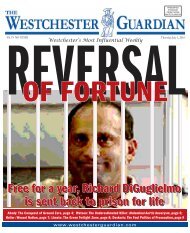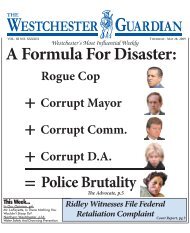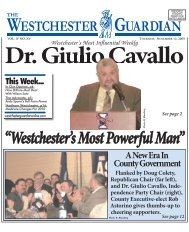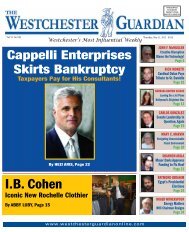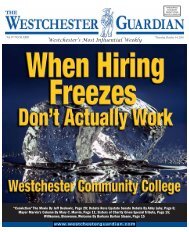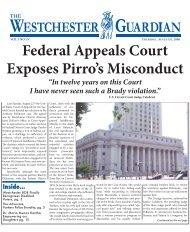March 14, 2013 - WestchesterGuardian.com
March 14, 2013 - WestchesterGuardian.com
March 14, 2013 - WestchesterGuardian.com
- No tags were found...
Create successful ePaper yourself
Turn your PDF publications into a flip-book with our unique Google optimized e-Paper software.
Page 10 THE WESTCHESTER GUARDIAN THURSDAY, MARCH <strong>14</strong>, <strong>2013</strong>CURRENT COMMENTARYThe Last Word On Retirement PlanningContinued from page 9withdrawals begin. Because the distributionsare based on the portfolio’s precrashvalue, the first withdrawals takeout more money than the portfolio canlater recover.The Journal’s article offered threealternative approaches. I dislike all ofthem, in varying degrees.The first, buying an annuity, is theworst. Annuities, sold by insurance<strong>com</strong>panies, are usually expensive to buyand expensive to hold because of variouslayers of fees. They substitute theinsurer’s investment results for yours,which may or may not be a good trade.If the insurer promises more than itslong-term investment results can deliver,you have to count on the <strong>com</strong>panyto make up the difference from its ownassets – for you and many other customers.Buying an annuity today alsomeans, in many cases, locking in today’srecord-low interest rates for the rest ofyour life. I don’t see why anyone wouldwant to do that.Insurers have developed all sortsof spin to try to counter these basicfacts. I am not buying any of it,and I’m not buying annuities, either.The second idea is to vary your annualportfolio withdrawals according tochanges in your investments’ value, andaccording to your remaining life expectancyas set out in tables publishedby the Internal Revenue Service. Thisidea will work pretty well for people intheir 60s and 70s, who have a decadeor two of remaining life expectancy andwhose annual withdrawals, in percentageterms, will be modest. It will workmuch less well for people in their late80s and 90s, when life expectancy dropsinto the single digits and the withdrawalrate, in turn, would rise to the doubledigits.The third approach is a stockanalyst’s technique of pegging yourwithdrawal rate to the stock market’sreported price-to-earnings ratio. Onlyan investment analyst would even thinkof trying to implement this approach,so I am not going to address it further,except to say that it seems to pay moreattention to the theory of what yourstocks ought to be worth than to thereality of what they actually are worth.All of these strategies are supposedto guarantee that you will not outliveyour money.That’s a useless guarantee – andto prove it, I am going to promise thatif you follow the simple strategy I amabout to give you, you will never outliveyour money. But you still may not behappy with the results.Here is my strategy: At the startof every year, take out 4 percent of yourportfolio for that year’s spending. Ortake 5 percent. Or 6 percent. Or 10percent, if you want.The next year, when you take outthe same percentage, your portfolio willhave either shrunk or grown, so yourwithdrawal will either shrink or grow,too. Obviously, the higher the percentageyou take out, the more likely it be<strong>com</strong>esthat your portfolio will shrinkrather than grow, so your annual distributionswill tend to shrink over time.But because you are only taking out afixed percentage every year, your portfoliocannot fall all the way to zero.If you choose a small percentage,your portfolio might gain value overtime, allowing your annual distributionsto increase. This is the way to go ifyou like to have a big financial cushionor if you are simply into deferred gratification.On the other hand, if you wantto have your cake right now and don’tworry about facing a bare cupboardlater, take a big percentage. It’s yourchoice.A lot of people will dismiss mymethod immediately. It does not guarantee– or promise – that the amountyou can spend every year will keepup with inflation. It does not promisethat your withdrawals will be enoughto support you in reasonable <strong>com</strong>fortforever. It does not promise that if youneed extensive care in your later years,you will have the money to pay for it.I do not promise these things becauseI don’t like to promise things Icannot necessarily deliver.If you are entering retirement,there are only a few things you cancontrol. You can control how much youspend; you can control how much youearn (if you are healthy enough to workduring your “retirement”); and you cancontrol how you invest your savings.If you put all your savings in the bankat today’s near-zero interest rates, youwon’t suffer any losses if the stock marketturns downward, but you will haveno chance whatsoever to grow your investmentsand keep up with inflation.If you put everything in the stock market,you will have growth opportunitiesover the long term, but you will see alot of short-term fluctuations in value(and thus in your annual distributions).You had best be prepared to stay in thestock market through any downturns,or you will suffer the fate of your neighborswho cashed in their 401(k) plansduring the crash a few years ago, whichlocked in their losses and preventedthem from subsequently recoveringalong with the market.You cannot control what the stockmarket will do in the future. You cannotcontrol inflation. You cannot controlhow long you will live. You cannotcontrol how much medical or custodialcare you will need. There is no financialstrategy or product that can give youcontrol over these things, which nobodyelse can control either.Our best chance of having a financiallysecure and <strong>com</strong>fortable retirementis to keep spending under control(downsize sooner rather than later)and to invest with an eye toward longtermgrowth. If you have a reasonablystrong stomach for withstanding stockmarket fluctuations, I think the logicalapproach is to have anywhere from 50percent or 80 percent of retirement assetsin stocks. This is as true for someoneat age 80 as at 60.We all want our old-age securityguaranteed, but life does not offerguarantees. It only offers promises, andpromises are not always worth much.Larry M. Elkin, CPA, CFP ® , has providedpersonal financial and tax counselingto a sophisticated client base since1986. After six years with Arthur Andersen,where he was a senior manager forpersonal financial planning and familywealth planning, he founded his own firmin Hastings on Hudson, N.Y., in 1992.That firm grew steadily and became thePalisades Hudson organization, whichmoved to Scarsdale, N.Y., in 2002. Thefirm expanded to Fort Lauderdale, Fla.,in 2005 and to Atlanta in 2008.MUSICTHE SOUNDSOFBLUEBy Bob PutignanoOtis Redding “Lonely & Blue”“A new twist concept release from the great Otis Redding” Rating: 7“Lonely & Blue: The Deepest Soul ofOtis Redding” is a brand new <strong>com</strong>pilationof Redding’s recordings that have neverappeared on a single album prior. It’s avery hip conceptual project that focuseson (as the title implies) that are mostlyballads. Well known hits like “I’ve BennLoving You Too Long,” and “These Armsof Mine,” appear, but this CD also offersbelow the radar titles. The story goes that<strong>com</strong>pilation producer David Gormanwanted to bring together titles that wereintended for late-night listening, and notto create yet another batch of Reddinghits. There’s even an alternate rendition of“I’ve Got Dreams To Remember” where(Rougher Dreams are added to the title.)According to Gorman; “the lyrics aredarker and tell a more personal story thanthe better-known hit version.”Otis’ voice and sparkling guitar lick(sounds like Cropper,) jumps out on thebeginning notes of “(I Love You) MoreThan You Can Say,” is mildly overproducedwith strings, but when the Staxhorns kick-in you’ll forget the violins,and focus more on the deep and soulfulrenderings of Redding. But ballad afterballad ensures, “Gone Again,” “Free Me,”“Open the Door,” and “A Waste of Time,”sound too similar in succession, and woreon me. The mood changes (a bit) on classicslike “These Arms of Mine,” and thestop – stuttering and gorgeous “I’ve BeenLoving You Too Long,” remain foreverbreathtaking. There’s also an interestingRedding-Cropper tune “Little Ol’ Me”it’s sweet and displays some slick bluesyguitar licks too.The aforementioned “I’ve GotDreams to Remember (RougherDreams,)” definitely adds new lyrics,the B3 is clearer here and more emotiveadding additional drama; it’s also mildlyrearranged from the original. “Send MeSome Lovin’” is also another wel<strong>com</strong>eballad that I don’t recall from any previousRedding recordings. The closing “MyLover’s Prayer” (by Redding) fittinglyconcludes “Lonely & Blue” on anothersomber note, yet the familiar Stax soundsand horns make this a delight. Needlessto say Redding delivers his vocals movinglyand memorably.Add to the mix that the packagingwas intentionally designed byContinued on page 11




